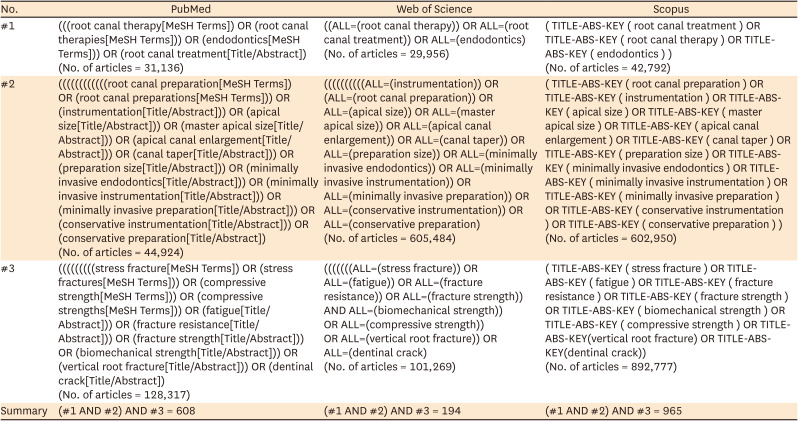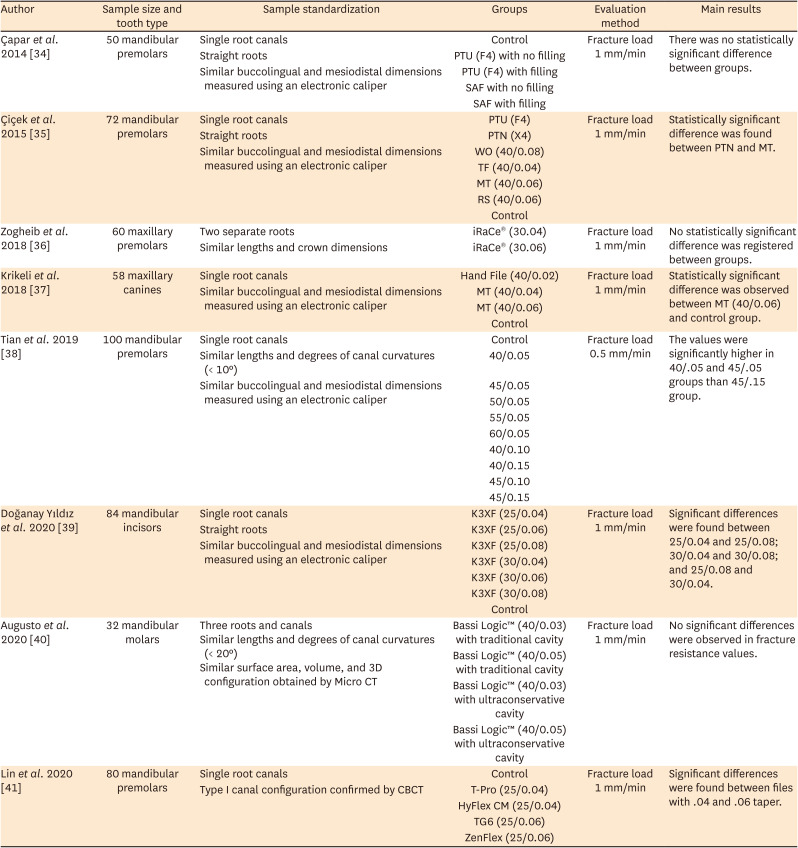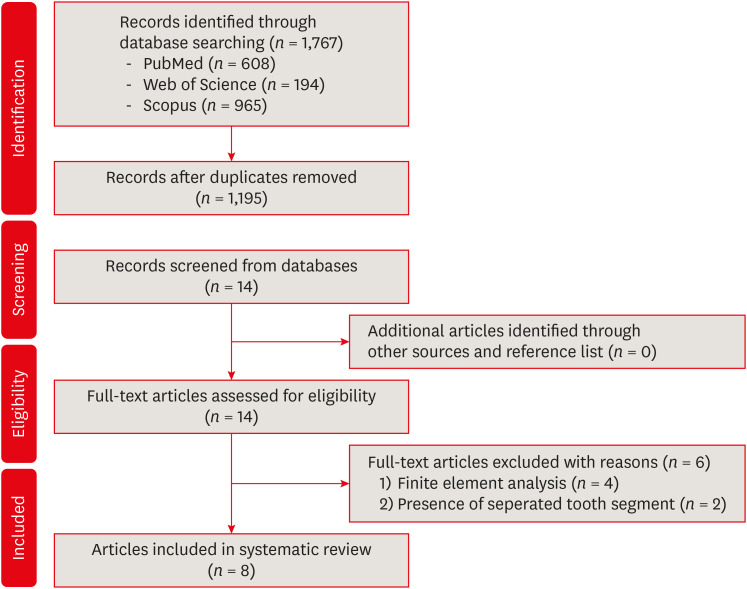1. Azim AA, Griggs JA, Huang GT. The Tennessee study: factors affecting treatment outcome and healing time following nonsurgical root canal treatment. Int Endod J. 2016; 49:6–16. PMID:
25582870.

2. Siqueira JF Jr, Rôças IN. Present status and future directions: microbiology of endodontic infections. Int Endod J. 2022; 55(Suppl 3):512–530. PMID:
34958494.

3. Lin J, Shen Y, Haapasalo M. A comparative study of biofilm removal with hand, rotary nickel-titanium, and self-adjusting file instrumentation using a novel
in vitro biofilm model. J Endod. 2013; 39:658–663. PMID:
23611386.

4. Haapasalo M, Endal U, Zandi H, Coil JM. Eradication of endodontic infection by instrumentation and irrigation solutions. Endod Topics. 2005; 10:77–102.

5. Boutsioukis C, Arias-Moliz MT. Present status and future directions - irrigants and irrigation methods. Int Endod J. 2022; 55(Suppl 3):588–612. PMID:
35338652.

6. Boutsioukis C, Gutierrez Nova P. Syringe irrigation in minimally shaped root canals using 3 endodontic needles: a computational fluid dynamics study. J Endod. 2021; 47:1487–1495. PMID:
34118256.

7. Siqueira JF Jr, Lima KC, Magalhães FA, Lopes HP, de Uzeda M. Mechanical reduction of the bacterial population in the root canal by three instrumentation techniques. J Endod. 1999; 25:332–335. PMID:
10530256.

8. Shuping GB, Orstavik D, Sigurdsson A, Trope M. Reduction of intracanal bacteria using nickel-titanium rotary instrumentation and various medications. J Endod. 2000; 26:751–755. PMID:
11471648.

9. Silva EJ, Ferreira VM, Silva CC, Herrera DR, De-Deus G, Gomes BP. Influence of apical enlargement and complementary canal preparation with the self-adjusting file on endotoxin reduction in retreatment cases. Int Endod J. 2017; 50:646–651. PMID:
27400743.

10. Marinho AC, Martinho FC, Zaia AA, Ferraz CC, Gomes BP. Influence of the apical enlargement size on the endotoxin level reduction of dental root canals. J Appl Oral Sci. 2012; 20:661–666. PMID:
23329249.

11. Brunson M, Heilborn C, Johnson DJ, Cohenca N. Effect of apical preparation size and preparation taper on irrigant volume delivered by using negative pressure irrigation system. J Endod. 2010; 36:721–724. PMID:
20307751.

12. Falk KW, Sedgley CM. The influence of preparation size on the mechanical efficacy of root canal irrigation
in vitro
. J Endod. 2005; 31:742–745. PMID:
16186754.

13. Mickel AK, Chogle S, Liddle J, Huffaker K, Jones JJ. The role of apical size determination and enlargement in the reduction of intracanal bacteria. J Endod. 2007; 33:21–23. PMID:
17185122.

14. Fatima S, Kumar A, Andrabi SM, Mishra SK, Tewari RK. Effect of apical third enlargement to different preparation sizes and tapers on postoperative pain and outcome of primary endodontic treatment: a prospective randomized clinical trial. J Endod. 2021; 47:1345–1351. PMID:
34058250.

15. Saini HR, Tewari S, Sangwan P, Duhan J, Gupta A. Effect of different apical preparation sizes on outcome of primary endodontic treatment: a randomized controlled trial. J Endod. 2012; 38:1309–1315. PMID:
22980168.

16. Barbosa AF, Lima CO, Sarmento EB, Cunha GG, Sassone LM, Lopes RT, et al. Impact of minimally invasive endodontic procedures on the development of dentinal microcracks. J Endod. 2022; 48:1146–1151. PMID:
35697303.

17. Moore B, Verdelis K, Kishen A, Dao T, Friedman S. Impacts of contracted endodontic cavities on instrumentation efficacy and biomechanical responses in maxillary molars. J Endod. 2016; 42:1779–1783. PMID:
27871481.

18. Rover G, Belladonna FG, Bortoluzzi EA, De-Deus G, Silva EJ, Teixeira CS. Influence of access cavity design on root canal detection, instrumentation efficacy, and fracture resistance assessed in maxillary molars. J Endod. 2017; 43:1657–1662. PMID:
28739013.

19. Wang Q, Liu Y, Wang Z, Yang T, Liang Y, Gao Z, et al. Effect of access cavities and canal enlargement on biomechanics of endodontically treated teeth: a finite element analysis. J Endod. 2020; 46:1501–1507. PMID:
32615176.

20. Plotino G, Özyürek T, Grande NM, Gündoğar M. Influence of size and taper of basic root canal preparation on root canal cleanliness: a scanning electron microscopy study. Int Endod J. 2019; 52:343–351. PMID:
30129186.

21. Valle AD, Dotto L, Morgental RD, Pereira-Cenci T, Pereira GK, Sarkis-Onofre R. Influence of root canal preparation on formation of dentinal microcracks: a systematic review. Braz Dent J. 2020; 31:201–220. PMID:
32667513.

22. Plotino G. Minimally invasive approaches in endodontic practice. Cham: Springer Cham;2021.
23. Lima CO, Barbosa AF, Ferreira CM, Augusto CM, Sassone LM, Lopes RT, et al. The impact of minimally invasive root canal preparation strategies on the ability to shape root canals of mandibular molars. Int Endod J. 2020; 53:1680–1688. PMID:
32767779.

24. van der Sluis LW, Wu MK, Wesselink PR. The efficacy of ultrasonic irrigation to remove artificially placed dentine debris from human root canals prepared using instruments of varying taper. Int Endod J. 2005; 38:764–768. PMID:
16164691.

25. Fornari VJ, Silva-Sousa YT, Vanni JR, Pécora JD, Versiani MA, Sousa-Neto MD. Histological evaluation of the effectiveness of increased apical enlargement for cleaning the apical third of curved canals. Int Endod J. 2010; 43:988–994. PMID:
20722756.

26. Navabi AA, Khademi AA, Khabiri M, Zarean P, Zarean P. Comparative evaluation of
Enterococcus faecalis counts in different tapers of rotary system and irrigation fluids: an
ex vivo study. Dent Res J. 2018; 15:173–179.

27. Paraskevopoulou MT, Khabbaz MG. Influence of taper of root canal shape on the intracanal bacterial reduction. Open Dent J. 2016; 10:568–574. PMID:
27857818.

28. Plotino G, Grande NM, Tocci L, Testarelli L, Gambarini G. Influence of different apical preparations on root canal cleanliness in human molars: a SEM study. J Oral Maxillofac Res. 2014; 5:e4.

29. Sabeti M, Kazem M, Dianat O, Bahrololumi N, Beglou A, Rahimipour K, et al. Impact of access cavity design and root canal taper on fracture resistance of endodontically treated teeth: an
ex vivo investigation. J Endod. 2018; 44:1402–1406. PMID:
30049471.

30. Saeed M, Al-Obadi M, Salim A, Alsawaf AY, Hadi K. Impact of access cavity design on fracture resistance of endodontically treated molars: a systematic review. Clin Cosmet Investig Dent. 2021; 13:1–10.

31. Silva EJ, Rover G, Belladonna FG, De-Deus G, da Silveira Teixeira C, da Silva Fidalgo TK. Impact of contracted endodontic cavities on fracture resistance of endodontically treated teeth: a systematic review of
in vitro studies. Clin Oral Investig. 2018; 22:109–118.

32. da Costa Vieira LC, Neves GS, Amaral G, de Berredo Pinho MA, Dos Santos AP, Dos Reis Perez C. Does the use of fiber posts increase the fracture resistance of simulated immature teeth? A systematic review. Odontology. 2022; 110:619–633. PMID:
35445361.

33. Faber J, Fonseca LM. How sample size influences research outcomes. Dental Press J Orthod. 2014; 19:27–29.

34. Capar ID, Altunsoy M, Arslan H, Ertas H, Aydinbelge HA. Fracture strength of roots instrumented with self-adjusting file and the ProTaper rotary systems. J Endod. 2014; 40:551–554. PMID:
24666910.

35. Çiçek E, Aslan MA, Akkoçan O. Comparison of the resistance of teeth instrumented with different nickel-titanium systems to vertical root fracture: an
in vitro study. J Endod. 2015; 41:1682–1685. PMID:
26211563.

36. Zogheib C, Sfeir G, Plotino G, Deus G, Daou M, Khalil I. Impact of minimal root canal taper on the fracture resistance of endodontically treated bicuspids. J Int Soc Prev Community Dent. 2018; 8:179–183. PMID:
29780745.

37. Krikeli E, Mikrogeorgis G, Lyroudia K. In vitro comparative study of the influence of instrument taper on the fracture resistance of endodontically treated teeth: an integrative approach-based analysis. J Endod. 2018; 44:1407–1411. PMID:
30032861.

38. Tian SY, Bai W, Jiang WR, Liang YH. Fracture resistance of roots in mandibular premolars following root canal instrumentation of different sizes. Chin J Dent Res. 2019; 22:197–202. PMID:
31508608.
39. Doğanay Yıldız E, Fidan ME, Sakarya RE, Dinçer B. The effect of taper and apical preparation size on fracture resistance of roots. Aust Endod J. 2021; 47:67–72. PMID:
33296118.

40. Augusto CM, Barbosa AF, Guimarães CC, Lima CO, Ferreira CM, Sassone LM, et al. A laboratory study of the impact of ultraconservative access cavities and minimal root canal tapers on the ability to shape canals in extracted mandibular molars and their fracture resistance. Int Endod J. 2020; 53:1516–1529. PMID:
32683704.

41. Lin GS, Singbal KP, Noorani TY, Penukonda R. Vertical root fracture resistance and dentinal crack formation of root canal-treated teeth instrumented with different nickel-titanium rotary systems: an
in-vitro study. Odontology. 2022; 110:106–112. PMID:
34269933.

42. Neelakantan P, Vishwanath V, Taschieri S, Corbella S. Present status and future directions: minimally invasive root canal preparation and periradicular surgery. Int Endod J. 2022; 55(Suppl 4):845–871. PMID:
35426157.

43. Card SJ, Sigurdsson A, Ørstavik D, Trope M. The effectiveness of increased apical enlargement in reducing intracanal bacteria. J Endod. 2002; 28:779–783. PMID:
12470024.

44. Yuan K, Niu C, Xie Q, Jiang W, Gao L, Huang Z, et al. Comparative evaluation of the impact of minimally invasive preparation vs. conventional straight-line preparation on tooth biomechanics: a finite element analysis. Eur J Oral Sci. 2016; 124:591–596. PMID:
27704709.

45. Sathorn C, Palamara JE, Palamara D, Messer HH. Effect of root canal size and external root surface morphology on fracture susceptibility and pattern: a finite element analysis. J Endod. 2005; 31:288–292. PMID:
15793386.

46. Chatvanitkul C, Lertchirakarn V. Stress distribution with different restorations in teeth with curved roots: a finite element analysis study. J Endod. 2010; 36:115–118. PMID:
20003947.

47. Bhanderi S. Facts about cracks in teeth. Prim Dent J. 2021; 10:20–27.

48. Shabbir J, Zehra T, Najmi N, Hasan A, Naz M, Piasecki L, et al. Access cavity preparations: classification and literature review of traditional and minimally invasive endodontic access cavity designs. J Endod. 2021; 47:1229–1244. PMID:
34058252.

49. Rahimi S, Ghasemi N, Jabbari G, Zaheri Z, Torabi ZS, Darehchi NR. Effect of different intracanal medicaments on the fracture resistance of the human root. Dent Res J. 2022; 19:9.

50. Cobankara FK, Ungör M, Belli S. The effect of two different root canal sealers and smear layer on resistance to root fracture. J Endod. 2002; 28:606–609. PMID:
12184425.

51. Prado M, de Lima NR, de Lima CO, Gusman H, Simão RA. Resistance to vertical root fracture of root filled teeth using different conceptual approaches to canal preparation. Int Endod J. 2016; 49:898–904. PMID:
26334132.

52. Küçükkaya Eren S, Uzunoğlu-Özyürek E, Karahan S. Influence of reciprocating and rotary instrumentation on microbial reduction: a systematic review and meta-analysis of
in vitro studies. Restor Dent Endod. 2021; 46:e19. PMID:
34123755.

53. Gray JA. Evidence-based healthcare. Amsterdam: Elsevier Health Sciences;2001.
54. Choudhry NK. Randomized, controlled trials in health insurance systems. N Engl J Med. 2017; 377:957–964. PMID:
28877014.








 PDF
PDF Citation
Citation Print
Print





 XML Download
XML Download